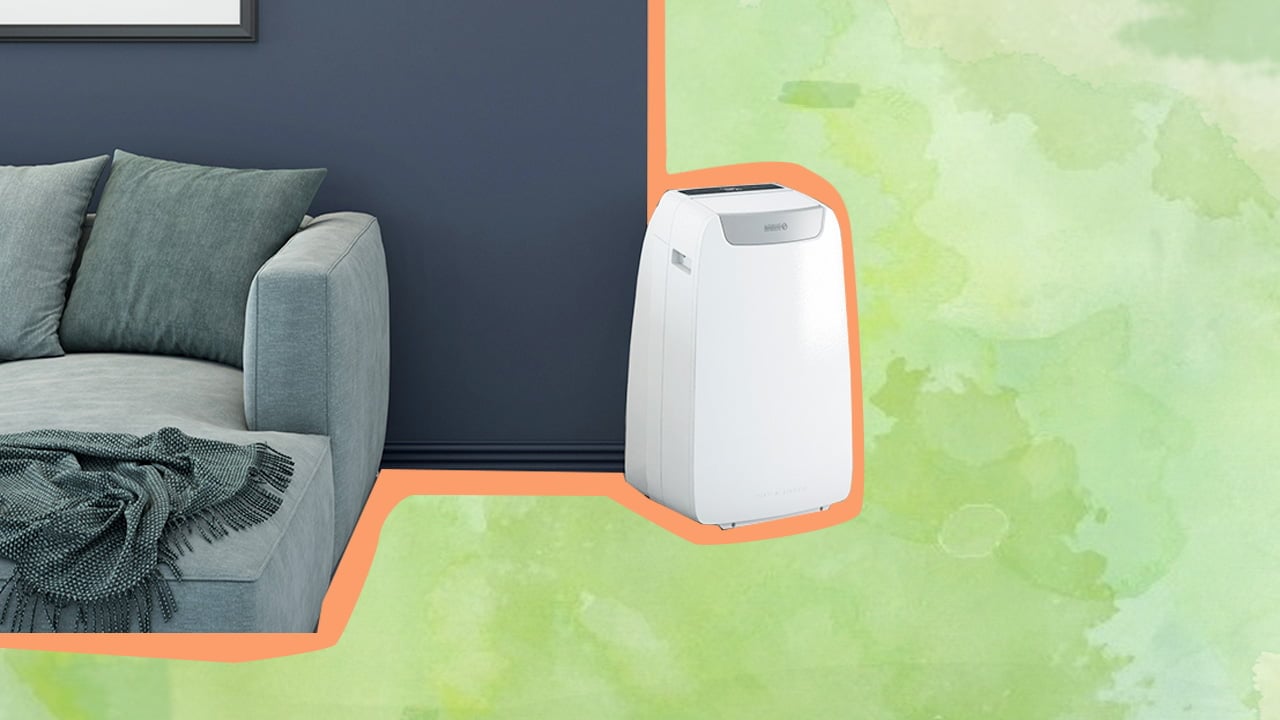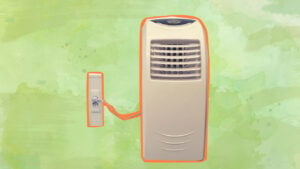A portable air conditioner is a compact and low energy-consuming unit that’s popular for its portability and easy usage; however, it requires an exhaust hose to operate. If you wish not to use the hose, you can consider other ways that include utilizing the door, window, fireplace, and even the walls.

The exhaust hose that comes with a portable AC helps it vent the heat from the refrigerant to facilitate better cooling and ventilation.
But installing the hose comes with several challenges, especially if you have windows that don’t allow fitting any pipe through it. And if you do use the AC without the hose, the hot air that’ll come out of the vent opening will cancel out the cold air it produces. So, it will not lower the room temperature at all.
To help you resolve this issue, I have carefully explained how a portable air conditioner works and suggested alternative ways to use it without an exhaust hose. Read on!
How Do Portable Air Conditioners Work?

Essentially, most air conditioning systems remove hot air from the indoor space and vent it outside. But while other AC types have indoor and outdoor units, portable ACs are single, compact units within which the entire air conditioning process takes place. First, the warm air is sucked into the unit through a fan that helps circulate incoming air. After passing through the fan, the air filter cleans the warm air.
This warm air then passes over the condenser coil filled with a refrigerant, which helps cool the indoor air by absorbing the heat into the evaporator coil. After the heat is absorbed, it is then transferred to the compressor coils for expulsion.
The refrigerant enters the cold evaporator coil in a liquid form. Since there is a huge temperature difference between the hot air and the cool refrigerant, the latter absorbs the heat from the former - this is how the cooling takes place. This cold air is then circulated back into the room until the air reaches the desired temperature.
Furthermore, since refrigerants (Freon, R-310 A, R-32, etc.) have a low boiling point, they absorb heat and evaporate. This gaseous refrigerant then passes into the compressor, which compresses it with high pressure - this helps the refrigerant to revert to its liquid state in the condenser. However, a fan needs to blow cold air over the condenser coils for this to happen.
This cooler air then absorbs the heat from the refrigerant, and all that hot air is expelled through the exhaust vent.
The exhaust is usually connected to the back of the portable air conditioning system and fitted through a window to allow efficient venting. For this, most portable ACs come with an additional vent hose and window installation kit.
Can You Use a Portable Air Conditioner Without the Hose?
Without the exhaust hose, the hot air that needs to be expelled outside will circulate back into the room. In this case, the room air will continuously go through heating and cooling cycles, which can ultimately increase the room temperature. This also increases the chances of your space being filled with humid air along with the heat generated by the refrigerant.
So, your portable air conditioner will continue to run without being able to achieve the desired temperature, thereby incurring high energy bills.
However, an exhaust opening and vent pipe can also be unsightly and ruin your interior decoration efforts. This is especially true for a portable AC with a dual hose that requires installing two vent pipes through a window or door gap. Besides its unattractive appearance, I’ve had plenty of difficulties finding the right place to fit the vent.
This has been a particularly hard job since I have sliding windows that tend to have a huge gap if I put the vent hose through them, making the room lose cool air. However, I’ve discovered some ways you can use a portable air conditioner without a hose, and I’m going to share those with you in this article.
Use Your Portable AC As A Dehumidifier
Before moving on to the different alternatives, let me bring to your attention the most common way to decrease indoor temperature without having to exhaust hot air. You can do this by simply setting your portable air conditioners to the dehumidifier mode.
As we all know, high humidity can make the air feel hotter than it really is since the moisture makes it difficult for our bodies to sweat and regulate heat. So, reducing the relative humidity of your space to 30- 50% can help your body cool off and automatically make the room feel comfortable. The excess moisture will be collected into the condensate pan or tank, which you regularly need to empty.
However, the dehumidifier setting will not allow high cooling settings, and your room temperature will be the same as before.
Alternatives to Using the Hose
Many people prefer to use an evaporative cooler (or ‘swamp coolers’), which are similar to portable ACs, but they don’t use an exhaust hose. These ventless portable air conditioners are quite effective for dry areas like computer service rooms; however, they don’t perform very well in humid conditions.
So, here are some alternatives to using a drain hose that will efficiently eliminate both heat and moisture:
1. Put The Portable Air Conditioner In the Door Gap
The easiest way to operate a portable AC without an exhaust hose is to place it next to a door opening to get the heat removed. You will need at least a five to six inches wide door gap, which you’ll have to align with the vent at the back of the portable AC (the vent is typically six inches in diameter).
You can use a sliding door or any other type as long as it can remain open without any support - this way, you can effectively exhaust the heat and humidity and keep the room cool and dry. This can be more efficient if you put it next to a door that opens to another room instead of outside to prevent the warm air outdoors from coming in. However, you’ll be left with a door gap no matter which door you put the portable AC next to.
Use materials like plywood, sheet plastic, cardboard, linen, etc., to close the door gap - but make sure you’re not closing the exhaust opening as it can lead to overheating. Blocking off the gap will also prevent most of the cooled air from escaping the room while you keep the door open. If this sounds inconvenient, you can purchase a vent kit for portable ACs, specifically designed for doors.
2. Mount The Portable AC On The Window
Exhaust hoses are specifically designed to help a portable air conditioner vent warm and humid air through windows instead of sliding doors. However, if you want to use a portable AC without an exhaust hose, you can simply place the unit near the window - similar to a window air conditioner!
You can do this in two ways:
- Put the portable air conditioner on the window sill
- Place the portable AC through the window so that it’s halfway outside, but ensure it’s tied down well, so it doesn’t fall off.
This solution works especially well if you have small windows that the portable unit can fully cover and exhaust the warm air through it - and that’s how window ACs work!
3. Make A Hole Into The Wall
Making a designated hole in the wall for the portable AC unit to vent the hot air is another way to resolve the exhaust problem. To do this, first, you’ll have to measure the exhaust opening at the back of the unit and cut a hole of the same size. Of course, you’ll need to align the hole in the wall with the vent opening to use it as an exhaust hose.
Put the portable AC in such a way that it’s as close to the wall as possible to prevent the hot and humid air from seeping into the way. Use a stool or other furniture piece for elevation, if required. This way, you can eliminate the waste air directly outside without risking the chances of toxic gasses from the refrigerant circulating in your home.
Warning: Before you decide to do it, make sure you give it considerable thought since the hole will need to be cut into the structure of the house. This means it’ll be permanent and can damage the surrounding wall.
4. Use Your Fireplace As The Exhaust Opening
If you have a fireplace in the house, you’ll notice a flue running through the chimney to the outside. So, it’s the perfect architectural structure for ventilation and eliminating the hot air. You can direct this air up the chimney in two ways.
Firstly, you can simply place the portable air conditioner in front of the fireplace with its back facing the fireplace opening. Then, block off all the space around the AC unit with plywood or similar materials to prevent the warm air from blasting back into the room.
Tip
Double-check if the flue is open while doing it, and ensure the plywood doesn’t block any vents in the portable air conditioner.
Secondly, you can use some DIY skills, cardboard, and silicone caulk to channel the airflow upwards for easy ventilation. Building such a channel can turn your fireplace into a DIY air conditioning system.

Final Thoughts
As you can already understand, it is quite possible to use a portable AC without a hose; however, it’s much simpler to use it with one. Even though you’ll need to re-evaluate your space and find a suitable place for the hose, it’ll be much easier to handle in the long run without damaging the house.
However, if you’re still irked by the exhaust hose and would rather do away with it, I recommend purchasing an AC unit that doesn’t require one. Consider installing a mini-split or a window air conditioner for better cooling and less hassle with the exhaust hose placement. If you already have a portable AC, simply use it as a dehumidifier in specific humid areas.
If you like this informational guide, check out my article on the best ventless portable air conditioners. See you next time!
